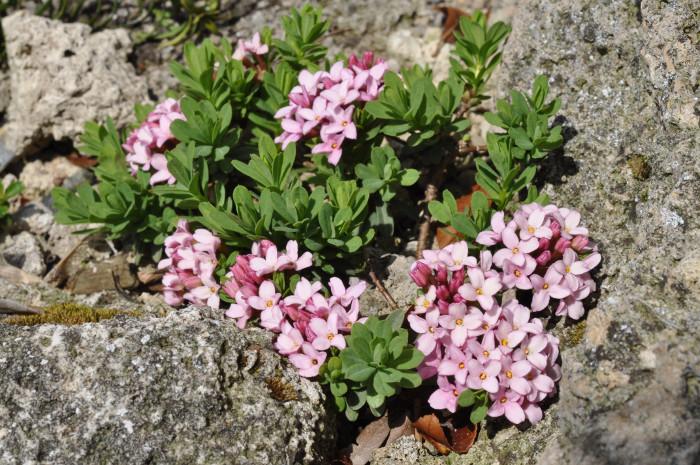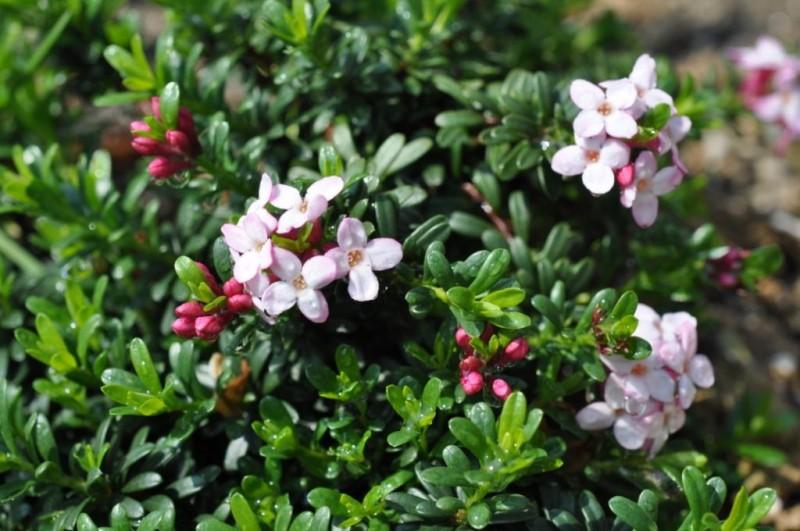Daphne and Apollo
Of all the shrubs that can be put in a rock garden, Daphnes are at the top of everyone's list. It helps to have the image of the nymph who escaped the lust-filled Apollo by turning into the laurel - now Daphne laureola. But plants must have more than mystique; gardeners are practical, earthy types, and their plants must perform. Two of my favorites are Daphne velenovskyi and Daphne arbuscula, and the derivative hybrids and cultivars.

Of the smaller Daphnes, D. velenovskyi is one of the best to grow. First described by Josef Halda in 1981 it grows on stony limestone soils covered with grasses and scattered Pinus mugo in the Pirin Mountains of Bulgaria, where the slopes are warm and dry. In the garden, I have found that it will tolerate both full, direct sun and less sun on a north facing, lightly shaded slope. The main caveat is that it sits high and receives benefit of air movement. Not as slow-growing as D. petraea, it sends forth a thick tangle of thin branches – the wood has a beautiful mahogany tone which compliments the pale, glaucous leaves. The flower buds emerge in late April, darkly colored red; and, burst out into a mass of bloom that enshrouds the whole surface. Flower color is basically pink, though it will vary in intensity. There is a white form that Jurasek found, but I have never seen it here. The fragrance is intense, and will draw the attention of the early insects and humanoids. It also, like many Daphnes, will rebloom in the autumn – for us it will bloom in November and the hard frost doesn’t damage the flowers. Best of all, it is one of the easiest Daphnes for anyone to grow. It transplants very well. However, D. velenovskyi does not thrive on tufa. It may grow in stony soil, but is not as saxatile as one might expect.
Daphne arbuscula, endemic to the limestone cliffs of the Muran River valley in Slovakia is comfortable on tufa. We grow 4 forms of it that Josef Halda collected many years ago. The best attribute of D. arbuscula is its ability to withstand extreme cold and retain its dark green color - as dark as any yew. Growing on those cold cliffs in the Muranskya, without any snow cover, it is often exposed to -30 C or worse. Flowers are lavender/pink with long corolla tubes and are sweetly scented.
Both of these Daphnes are in the same group as D. cneorum, which are commonly grown in the nursery trade as a field grown specimen, pushed with fertilizer, potted into a container and quickly moved to a garden centre. The failure rate is high ~30% and a source of irritation for the gardener and the retailer. Container growing them would help, but they would never have the “full” appearance that the garden centers want. So, you won’t find many Daphnes offered in the regular trade, but they are far more growable than industry folk-lore would have you believe.

Especially delightful and of easier culture are the hybrids developed in the last 20 years. D. petraea and its selections are quite beautiful, but very slow to grow. The hybrids of D. petraea maintain a compact habit, but are quicker to establish. In particular, D. x hendersonii (D. cneorum x D. petraea) has produced several good cultivars, some from Robin White’s Blackthorn Nursery. Leaves are typically small, glossy and dark green. Cultivars to look for are ‘Ernst Hauser’, ‘Aymon Correvon’, ‘Appleblossom’, ‘Kath Dryden’, and ‘Rosebud’. Cultivar ‘Ernst Hauser’ is larger than the others. Flower colour varies from shell pink ‘Ernst Hauser’ to the purplish red of ‘Rosebud’. D. x whiteorum is another cushion shrublet based on crosses of D. petraea and D. jasminea. Cultivar ‘Beauworth’ looks more like D. petraea with reddish pink flowers of good size and dark green leaves. D. x ‘Kilmeston’, a reverse cross of the same parents is more like D. jasminea with the grayish leaves and purple tint to the whole plant that cold weather imparts. Given a warm site, it blooms prolifically over an extended period.

Rick Lupp has produced 2 new hybrids that he felt were worth naming – in this case after his 2 granddaughters. D. x ‘Kelsey Ann’, a cross of D. velenovskyi and D. petraea ‘Grandiflora’, is a small, densely branched shrublet that will follow the contour of a rock or spill over the edge of a trough. Leaves are ovate like D. velenovskyi, but smaller. The blooms are pink and white with a heavy fragrance. D. ‘Maisey Larae’ is the offspring of the Caucasian D. circassica and D. arbuscula. More dome-shaped, it has narrow leaves and the darker colored flowers of D. circassica – with fragrance of course. According to Rick, it is still small enough for a trough.
Daphne ‘Leila Haines’, although it is an older selection, has such vivid coloration (dark red/purple) that it always attracts attention. Described by Halda as a hybrid of D. striata and D. cneorum, and by others as merely a variation of D. cneorum, it is a lovely and distinctive plant whatever its origin may be. The overall habit resembles D. cneorum with a dense mat of spreading branches thickly cloaked with narrow, dark green leaves. This effectively sets off the rich red color of the flowers – and it is intensely fragrant.
Lastly, D. x ‘Lawrence Crocker’ is what could be called the “everyman’s daphne” as it is of such easy culture. A moderate-sized dome develops quickly – with its dense root system it transplants easily. With these 2 qualities being recognized by the horticultural industry, it is rapidly turning up on wholesale lists. It also is a reliable bloomer that will present a good display of flowers through the seasons until winter comes.
If you look at the 2 most recent monographs on the genus, one by Robin White and a more detailed treatment by Josef Halda, you will wonder why more of these wonderful plants are unavailable. Commerce is more concerned with mass marketability. As a result, internet based commerce is helping to open the market.

Comments (0)
Add new comment